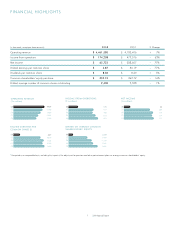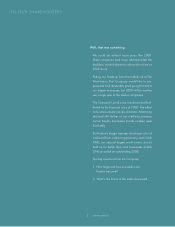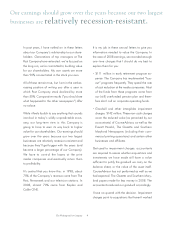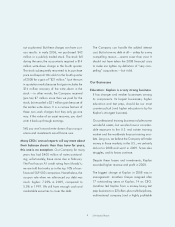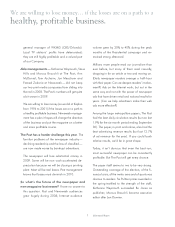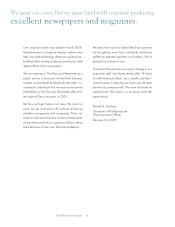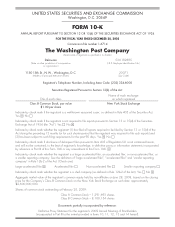Washington Post 2008 Annual Report Download - page 6
Download and view the complete annual report
Please find page 6 of the 2008 Washington Post annual report below. You can navigate through the pages in the report by either clicking on the pages listed below, or by using the keyword search tool below to find specific information within the annual report.In past years, I have rattled on in these letters
about our Company’s relationship to our share-
holders. Generations of top managers at The
Post Company have reiterated: we’re focused on
the long run; we’re committed to building value
for our shareholders. My own assets are more
than 90% concentrated in the stock you own.
All of these remain true, but I am in the embar-
rassing position of writing you after a year in
which Post Company stock declined by more
than 50%. Comparative results (“you should see
what happened to the other newspapers”) offer
no solace.
While it feels foolish to say anything that sounds
ironclad in today’s wildly unpredictable econ-
omy, our long-term view is: this Company is
going to have to earn its way back to higher
value for our shareholders. Our earnings should
grow over the years because our two largest
businesses are relatively recession-resistant and
because they’ll get bigger with the years (and
become a larger percentage of our Company).
We have to control the losses at the print
media companies and eventually return them
to profitability.
It’s central that you know this: in 1998, about
75% of the Company’s revenue came from The
Post, Newsweek and our television stations. In
2008, almost 70% came from Kaplan and
Cable ONE.
It is my job in these annual letters to give you
information needed to value the Company. In
the case of 2008 earnings, we recorded enough
one-time charges that I should do my best to
explain them for you:
•$111 million in early retirement program ex-
pense. The Company has implemented “buy-
out” programs frequently. They speed the rate
of cost reduction at the media companies. Most
of the funds from these programs come from
our (still) overfunded pension plan and there-
fore don’t call on corporate operating funds.
•Goodwill and other intangibles impairment
charges: $142 million. These non-cash charges
cover the reduced value (as perceived by our
accountants) of CourseAdvisor, as well as the
Everett Herald, The Gazette and Southern
Maryland Newspapers (including their com-
mercial printing operations) and certain other
businesses and affiliates.
Get used to impairment charges: accountants
are required to assess whether acquisitions and
investments we have made still have a value
sufficient to justify the goodwill we carry on the
balance sheet, or the value of the asset itself.
CourseAdvisor has not performed as well as we
had expected. The Gazette and Southern Mary-
land papers made far less money in 2008. The
accountants reduced our goodwill accordingly.
I have no quarrel with the decision. Impairment
charges point to acquisitions that haven’t worked
Our earnings should grow over the years because our two largest
businesses are relatively recession-resistant.
4
The Washington Post Company



